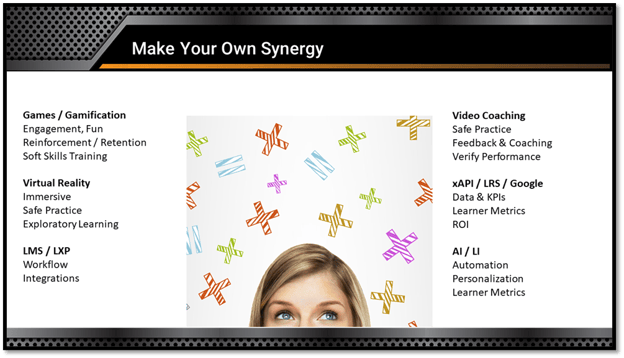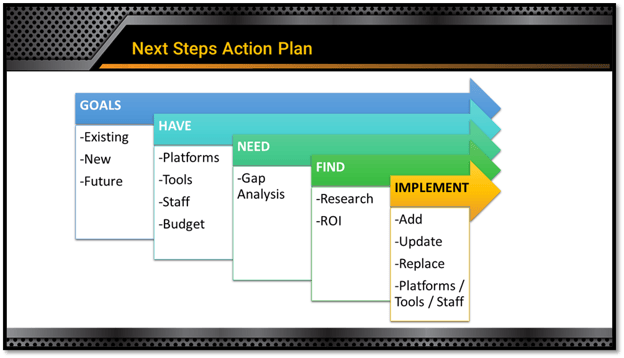This article is a follow-up to a Leader Talk webinar I presented for Training Industry on May 11, 2023. We’ve come a long way from converting PowerPoints to eLearning courses. New and existing technologies enable us to create more engaging and immersive learning experiences, provide personalized support, work more efficiently, and collect learner metrics that drive performance. Many of these technologies easily integrate with major Learning Management Systems (LMS). By adding the correct tools, you can take your learning department to the next level.

GAMIFICATION
The major interest expressed by webinar attendees was the need to make learning more fun and engaging. One approach is to add a game to a SCORM course or launch it directly from an LMS. Some people may be concerned about the risk of games distracting users from the learning content. However, the games I am referring to require the learner to know or understand the content to score well, thus reinforcing learning. Another approach is to use a gamified platform like Arcades™, which in addition to games, provides learner metrics, badges, and a company leaderboard.
- ACTION ITEM: Research gamification tools such as The Training Arcade®.
VIDEO COACHING
We also saw that people were very interested in ways to provide employees with feedback and coaching, or document employee performance. Video coaching tools enable employees to submit videos of their performance for feedback, and some do a lot more. Video coaching can be integrated into SCORM-based role plays or included in a learning path. If you need to scale this globally or across a large number of employees, you’ll want to look for one that includes translation and automation features.
- ACTION ITEM: Research video practice and coaching apps such as Rehearsal.
LMS/LXP
Surprisingly, the third most popular technology from our viewer poll was the category of LMS and LXP. While all have the same goal of delivering training to users, these platforms vary widely in optional features. Choosing one with features such as AI translation, social learning, and personalized learning paths can eliminate the need to add them later. What many people overlook is the workflow process, which dictates the time and cost it takes to manage the platform. To appear competitive, some vendors offer so many features that the workflow gets very complicated. You should understand these requirements before deciding.
- ACTION ITEM: Research LMS/LXP platforms such as the Rockstar Learning Platform workflow.
VIRTUAL REALITY / AI & LI
VR and AI also garnered a lot of interest. Immersing the learner in a real or virtual world may be the better choice for some types of learning where hands-on practice is either too costly or not feasible. What may surprise you is that VR can be a good way to encourage exploratory learning and personalized learning paths. Combine that with detailed tracking of user actions and this can be a valuable addition to your toolset.
Artificial Intelligence has many applications and can be found in some of the previously discussed technologies. In addition, there are many third-party AI apps such as text-to-speech, speaking heads, and image generators that can save you time and reduce costs. If you are looking to create adaptive courses, check out the Learner Intelligence Adaptive Design Model that I developed. It does not require AI and is free to use. You can download templates from my blog listed below.
- ACTION ITEM: Research VR tools such as CenarioVR®.
- ACTION ITEM: Learn about LI at The Center for Learner Intelligence.
DATA and METRICS
In many industries big data, analytics, and predictive insights rank very high in importance. With the right data, we can better understand the needs of our learners, and where our training can be improved. Some data is provided by learning platforms, and some of the technologies we have already mentioned also provide learner metrics. Look for an upcoming blog post where I’ll take a deeper dive into this topic.
- ACTION ITEM: Schedule a meeting with Dom to learn more.
These technologies help you to create better learning experiences by adding additional functionality. What technologies do you need to add to achieve the goals set by your learning organization? To help answer this question I prepared the following action plan.

Goals: Your choice of technologies largely depends on what your goals are. For example, a small learning department may need an LMS that’s easy to manage and has a good way of reusing existing assets. A large company may need a strategy of scaling and automating video coaching for thousands of users. Be aware of your learning goals before searching for new technologies.
Have: Take a good look at what you are already using. Which tools are aligned with your goals and which tools do not? Where are you strong or weak? This will help you in the next step.
Need: Now you are ready to do a gap analysis. What is missing from your toolset or talent pool? What is keeping you from reaching your goals? Be honest here, even if it looks like way more than you will be able to deal with.
Find: Now it’s time to do your due diligence. There are many good products out there. Ask vendors what their strengths and weaknesses are. Understand how you will work with their product. Is this a product you can grow with? You will need to have a good understanding of the benefits the product brings, both an increase in revenue as well as cost savings. Then you can calculate a reasonable ROI.
Implement: Congratulations when you make it to the implementation stage. You’re about to step up your game. Call on the vendor’s support staff to help you add the new technology and train your staff if that is needed. You may want to schedule a follow-up meeting with the vendor to make sure your expectations have been met and make any adjustments that may be necessary.
CONCLUSION
The learning industry, like many others, is rapidly evolving and all of us need to keep up. As is evident from this article, there are many proven technologies that you can implement today that will help improve employee performance. There are also many more on the way. I hope you find this growth and change as exciting as I do.







